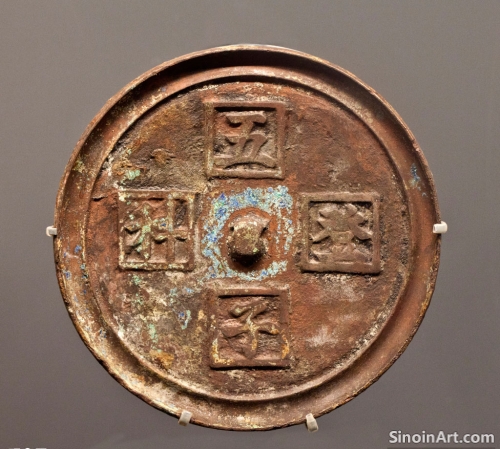The Influence of Ancient Chinese Bronze Ware on Later Japanese Art and Design
|
The impact of Chinese bronze ware extended far beyond the borders of China, significantly influencing the development of art and design in Japan, where the adoption and adaptation of Chinese styles resulted in a unique and rich artistic tradition. The influence of China on Japan helped to shape the artistic traditions of the region. The blending of Chinese forms with local sensibilities helped to produce uniquely Japanese styles of art.  Japanese artists and craftsmen were deeply inspired by Chinese bronze ware, adopting many of their forms, motifs, and decorative techniques, while also incorporating their own cultural preferences. The Japanese artists were able to both replicate and also transform the original designs, bringing their own unique cultural sensibility to the work.  Bronze vessels, mirrors, and other objects with Chinese stylistic origins can be found in Japanese art and architecture, demonstrating the lasting influence of the designs and techniques used in ancient China. The Chinese bronze designs were a central influence on many of the Japanese artistic forms that followed.  The study of bronze objects in Japan reveals the complex process of cultural exchange, adaptation, and innovation, highlighting the way that different cultures can interact and transform one another over time. The cross-cultural exchange helped to generate new and interesting approaches to the creation of art and to further enhance the overall artistic landscape of both cultures. The influence of ancient Chinese bronze ware on Japanese art serves as a reminder that artistic styles are constantly evolving, and that cross-cultural influences are a valuable source of creative energy. The ability of different cultures to share ideas helps to create a more vibrant and dynamic artistic landscape. The impact of the ancient Chinese styles continues to be felt even today. |
Tag : Japanese bronze art, Chinese influence, cross-cultural exchange, artistic styles, shodo
Related information
- The Role of Bronze in Ancient Chinese Funerary Practices: Preparing the Deceased for the Afterlife
- Analyzing the Surface Patina of Chinese Bronze Ware: A Story of Time and Environment
- Bronze Ware as Grave Goods: Status, Belief, and the Afterlife
- Bronze Ware and Ancient Chinese Concepts of Harmony: Balance, Symmetry, and the Cosmos
- The Enduring Appeal of Chinese Bronze Ware: Timeless Art and Cultural Legacy
This article explores the role of bronze in ancient Chinese funerary practices, highlighting the inclusion of ritual vessels, weapons, mirrors and other objects, and how these items reveal beliefs about the afterlife and the preparation of the deceased for their journey.
This article explores the surface patina of Chinese bronze ware, discussing its formation, its value as a historical record, the factors that influence its appearance, and the techniques used to distinguish between natural and artificial patinas.
This article explores the use of bronze ware as grave goods in ancient China, highlighting its connection to beliefs about the afterlife, the social status reflected in the types and quantities of objects, and how the placement of these objects reveals insights into ritualistic practices.
This article explores the influence of ancient Chinese concepts of harmony on bronze ware, highlighting the importance of balance, symmetry, precise proportions, and the connection of these principles to a wider understanding of the cosmos.
This article emphasizes the enduring appeal of Chinese bronze ware, highlighting its timeless beauty, its blend of function and symbolism, its ability to connect us with the ancient world, and the importance of continued study and preservation for future generations.